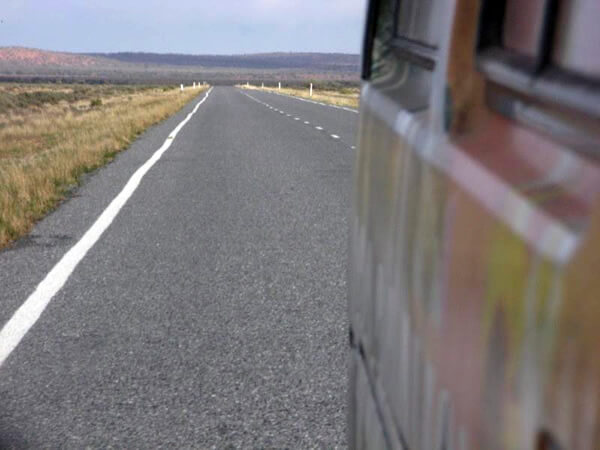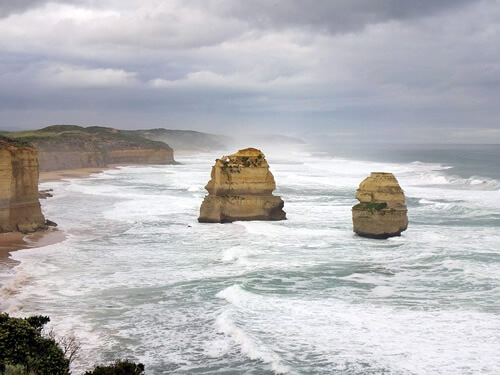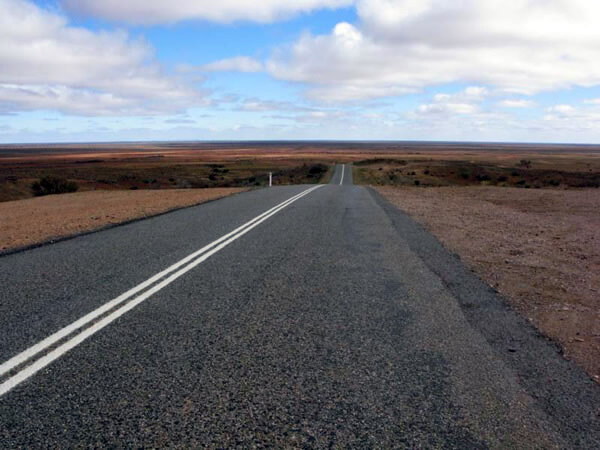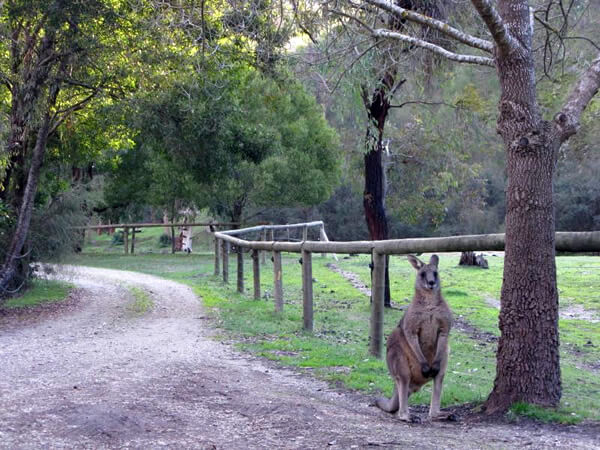How to Plan Campervan and Motorhome Trips in Australia
A Classic Way to Travel Across a Vast and Diverse Continent
Story and photos by Nora
Dunn
Resources updated by Transitions Abroad 2/3/2024

|
|
The road behind seen from a campervan
with everything from deserted beaches to kangaroos
lying ahead in the diverse and vast country.
|
Exploring Australia with a campervan
is a classic road trip. Many areas of this vast country
are remote enough that to really enjoy the quiet splendor
of the Australian landscape you need to be relatively self-sufficient.
And Australian campervan holidays are not only a popular
option for those visiting from overseas, but native Australians
are also renowned for loving the campervan and caravan circuit.

|
|
Twelve apostles, Australia just
one of many places to travel. Photo by Canari.
|
However without proper planning, traveling
in a campervan can be more expensive than you might think.
When an offer came to “see a slab of Australia for
free” by virtue of winning a free six week campervan
rental, I was over the moon. Although I had never traveled
extensively in a campervan before, I figured it would be
a fabulous and inexpensive trip. Sadly though, those six
weeks were among the most costly of all my full-time budget
travel thus far.
But it doesn’t have to be that
way. During my 6-week adventure, I learned a lot about how
to plan an itinerary, keep the cost of an Aussie campervan
holiday low, and how to budget for it next time around.
Here is a guide to planning and budgeting
for your own Australian campervan adventure.
Planning Your Campervan Route and Itinerary
Before you even choose your wheels,
it is best to plan what you want to see in Australia. It
is a huge country, with varying climate and road conditions.
Some stretches of road (for example through the Outback
or across the Nullarbor desert) involve huge expanses where
there is absolutely nothing — no petrol stations, no
food, no services, no power, no mobile reception, and no
water. Some campervan rental companies will not allow you
to travel on these roads at all, and even if you are allowed,
you must be well prepared.
Be wise about how long you plan your
Australian road trip to be as well. Unlike Europe — where
you can drive for a few hours and end up in a different
country — in Australia you can drive for days between
cities. It is best to allow more time than you expect you
will need, so you are not under the gun to get to the finish
line.

|
|
In the massive country of Australia
you can drive for days between cities.
|
Climate in Australia
An important part of choosing your route
is to understand Australia’s climate. Being in the
southern hemisphere, summer is from December-February and
winter is from June-August. However, although some states
may have snow in winter months, winter is not necessarily
cold everywhere; the temperatures in the north are warm
to hot year-round, and summer in the south can still experience
temperatures in excess of 50 degrees Celsius.
The ideal time to travel in Australia
tends to be the spring and autumn seasons for their all-around
moderate conditions. This helps you avoid Australia’s
climatic extremes; summer in the north can see impassable
flooded roads and fierce tropical storms, while winter in
the south can be cold enough for snow to fall (which means
chilly camping conditions).
Just to confuse things further, Melbourne
is known for being a city of “four seasons in a day” — quite
literally. So it is best to research the climate along your
desired route in order to be properly prepared.
The Australian Bureau of Meteorology
is a great resource for researching Australia’s climate.

|
|
Flora and fauna change
seasonally, and the occasional kangaroo will greet you.
|
Choosing Your Wheels
Campervans are typically utility-sized
vans that are outfitted with the basic essentials for you
to be self-sufficient: beds, sinks, crockery, cooking facilities,
and a fridge. Depending on the size of the vehicle, you
may also find toilet and shower facilities, but these are
often reserved for larger motor homes. Alternately you can
choose to go with an even smaller vehicle than a campervan
(such as a station wagon, minivan, pop-top, or 4x4), and
supplement it with traditional camping gear.
Your choice of vehicle will be dependent
on how many people there are in your party, where you want
to go, your budget, and the level of comfort you require.
To Rent or To Buy?
Many campervan and other car rental
companies offer an option for you to buy or purchase the
vehicle. If you buy it, a buy-back guarantee often comes
with the price, so you may be assured that you are not stuck
with a vehicle you can’t sell at the end of your trip.
The buy-back amount varies, but is often around 50% of your
purchase price. More often than not, you will fetch a better
price by selling privately, but the buy-back guarantee can
provide peace of mind in case you are in a bad location
to sell or run out of time.
The general guideline for the cost-effectiveness
of renting versus buying is as follows:
-
Less than eight weeks: It is almost
always best to rent, no matter what vehicle you choose.
-
More than eight weeks: It is more
cost-effective to purchase a car, minivan, or pop-top
vehicle.
-
More than 16 weeks: It is more cost-effective
to purchase a campervan or small motor home.
Tips for Renting a Campervan in
Australia
-
Book well in advance, as this form of travel is popular and vans are reserved well in advance.
-
Be prepared to drive standard; most
campervans have manual transmission.
-
You drive on the left-hand side
of the road in Australia.
-
You usually have to be at least
21 years old to rent a campervan.
-
Although it is common to pick up
and drop off your vehicle in different locations, check
with your rental company to ensure they have a drop off
location at your desired final stop and confirm if there
are any extra fees to do this.
-
Weekends are slow in Australia;
don’t expect the rental company to be open for
pick ups or drop offs; call in advance to check.
-
Insurance charges vary from company
to company; some have mandatory charges while others
do not.
-
Advise the rental company regarding
your desired itinerary. There are a number of roads that
rental companies will not allow you to travel on, including
unpaved or remote roads. At other times of year, some
roads are impassable or require a special vehicle with
a snorkel. The rental company should fit you with a vehicle
that is appropriate for your planned route and time of
year.
-
Equipment and conveniences included
with the campervan vary. Make sure you have everything
you want. Be prepared to supplement along the way with
creature comforts like extra blankets for the cold climes,
or a coffee pot for your morning cup.
-
There are stretches of road in Australia
so remote that rusted out broken-down cars are simply
abandoned at the side of the road, eerily making you
wonder what happened to the owner. Make sure your vehicle
is solid (especially if you buy it), so yours doesn’t
become one of the rusty statistics.
Camping with a Campervan in Australia
The expense of camping surprised me.
I figured that with a campervan, I had free accommodation
at my fingertips. But you cannot camp inside city limits,
or at the side of the road, and sometimes even rest areas
are off-limits for overnight stays. So unless you do some “renegade
camping” (in which you should be prepared for a knock
on the window at 3 a.m. by a police officer telling you
to move along — or worse yet waking up to a ticket),
you will often have to pay to park your wheels for the night.
Luckily due to the widespread popularity
of campervan
and motorhome holidays in Australia, caravan
parks are everywhere. Powered campervan sites will cost
you up to $40/night, and un-powered sites can cost up to
$25/night. (See below for some tips on powered versus un-powered
travel).
Caravan parks and campgrounds are a
fabulous way to meet other travelers. Caravan parks give
you access to showers, laundry, cooking facilities (sometimes
cooking in the van can be cramped), and a variety of amenities
that vary from park to park. Campgrounds also vary dramatically
in amenities depending on the location.
By contrast, after a few nights of saving
money and “renegade camping,” I was terribly
lonely. Shy of going to a café or pub (and spending
money, which is counterproductive), there is no way to meet
people if you camp alone. This, combined with the hassle
of finding toilet facilities in the middle of the night
and the stress of being asked to move or awaking to a ticket,
makes renegade camping pretty unattractive, even if it is
free.
The good news is that with some research
and networking with fellow travelers, you can find your
share of free — or inexpensive — camping spots.
To find the good stuff, you often have to buy a book, but
a books will pay for itself in the long run. Camps
and Caravan Parks offers
a series of books profiling camps and caravan parks.
Powered Versus Un-powered Campervans
Your campervan will likely have a function
to provide electrical power to a fridge, lights, and some
outlets so you can enjoy your creature comforts. This power
source is usually recharged when you drive over 80km/hour
or so for a few hours. But if you wish to stay in one place
for a few days, if you are driving smaller distances or
through the city, you may end up eventually losing power
if you don’t plug the van into a power source.
After staying in the driveway of a new
friend of mine for a few days, I lost all supplemental power
in the campervan. Most of the food in the fridge spoiled,
I could not run the water, and I was unable to charge my
computer. Traveling after that time became an exercise in
ensuring that at least every third night I paid for a powered
site.
Powered sites come at a premium at caravan
parks, costing an extra $2-15 per night. So when you don’t
need the power or have a full battery from highway driving,
you can avoid the charge by choosing an un-powered site.
The Cost of Fuel Down Under
The farther you get from the city, the
more you will pay for fuel. I paid anything from
$0.98/liter to over $1.50/liter in a 6-week period and current petrol prices in Australia have recently increased but can easily be found online. Of course, with your entire home on wheels, you can expect
to pay considerably more for fuel than you would to drive
just a car.
Expedition Australia has a terrific
tool for calculating the cost of fuel for your campervan trip, including a widget that calculates your cost based on your estimated kilometers and vehicle type. The site also offers a spreadsheet download to calculate the cost of driving around the vast country.
Australia is best seen from the road,
which explains the popularity of Aussie road trips among
both travelers and locals. And with proper planning and
budgeting, your own campervan holiday in Australia can be
incredibly fulfilling without emptying your wallet.
Nora
Dunn is a Professional Hobo and
widely published international writer, digital nomad, and a major social media influencer on a wide range of topics of travel on the cheap since her endless travels began in 2007. Find out her current whereabouts at www.theprofessionalhobo.com.
|
